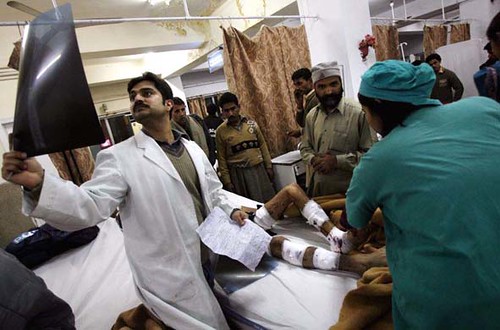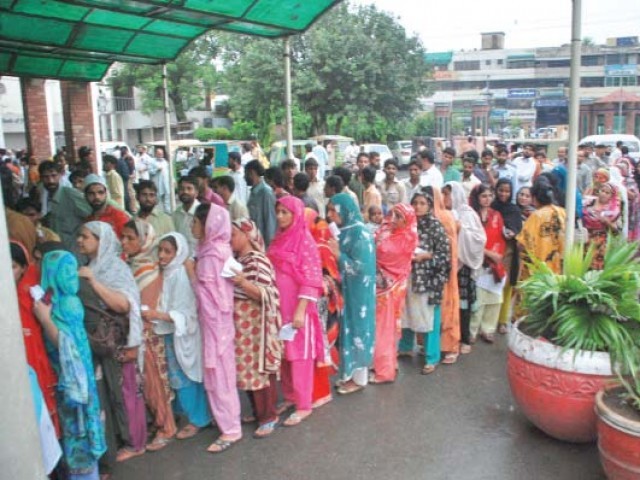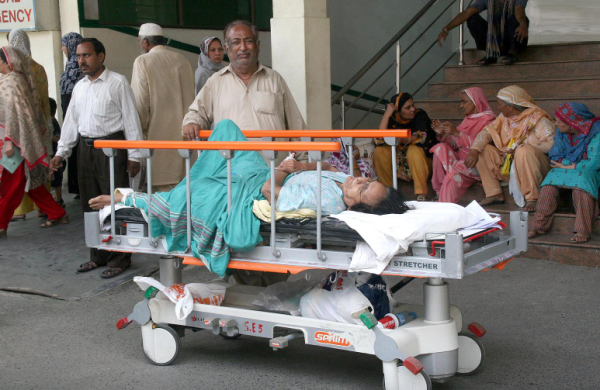Medicine is one of the noblest professions, concerned primarily with serving humanity. Pakistan produces a fair share of medical students, approximately 14,000 each year out of a total of 50,000 to 60,000 medical practitioners. Despite the significant number of doctors and about 70% of them being women, doctors in Pakistan are still scant as against the ever increasing population. While there is considerable argument that about 50% of the graduates never work a day in their life after their graduation, the remaining 50% promulgate that they don’t work under optimal conditions either.
The government hospitals in Pakistan paint a grimly picture of what medical care is meant to be in 2017. For this reason I surveyed three government hospitals in Lahore to get a closer look at how they were being managed. I do realize that Ganga Ram, Services and Mayo Hospital alone aren’t a standardized sample of government hospitals in Pakistan, but I would focus on how these three, being the most prominent in Punjab, and how they are managing the huge influx of patients.

Services Hospital
The hospital wards, hosting on average 1.4 million patients annually (according to statistics at Services Hospital) resemble the catastrophe at the Linda Vista Hospital from Pearl Harbor. The long corridors, characteristic of the British Raj architecture are nothing short of lifeless bounds of unkept pathways lined with patients’ relatives spewed from the wards after visiting hours. Life at these hospitals isn’t easy. The humid air seems pungent with disease and the age old walls tell tales of death and decay.
Ganga Ram, where patients have to pay only Re 1 (admission fee) for a Rs 20,000 worth of C-section had little kittens playing outside the gynae ward, on the floor of which sat the new mothers’ relatives eating out of large pots. The hospital lacked the discipline that it should present its patients with. Underneath each of the fans, which were still too few, an entire family sat with their lunch packed in large cooking pots. Families who had to travel from other parts of Punjab to Ganga Ram were distinctive because they had to sleep on the floors outside the medical wards; some had hand woven rugs while others flattened out pieces of cardboard. At the Services Hospital the patients weren’t lined in the corridors mainly because they were filthy and the few benches that existed were broken. They were more dispersed along the parking lots where few mattresses had been attached on stands, some of which were also broken.
“There is no need for such a large number of relatives to be present with the patient; only causing inconvenience to the hospital staff”, said Shazi Malih, Ganga Ram evening head nurse. While I concur with her statement, one needs to understand that the patients coming from towns/villages far away from Lahore need their family members, even though one or two would suffice. There are no proper waiting rooms and as wards are only meant to be for the patients, it becomes difficult for these relatives to respect the visiting hours. However, with experienced practitioners like Shazi Malih, visiting hours are kept in check by the nurses under her command what engenders, though, are long quarrels for which there needs to be a permanent solution. The hospitals have enacted their policies, the practitioners are always adamant in following them, however there seems to be an inherent desire in Pakistanis to break these rules and disobey the authority. Little do these people realize that their actions are detrimental to the entire system of medical care present at these hospitals.


Mayo Hospital
To my surprise, the patients were satisfied with the treatment they were being given. Shehla Tariq, who had come to Ganga Ram for pancreatoscopic removal of stones said, “The doctors conducted rounds twice a day and have given me proper attention, addressing all my queries and most importantly explaining my mother all the procedures that I had to go through to her satisfaction.” I was assured at Services Hospital by Attiya Abbas who had come with her husband to Services Hospital for his neurosurgery that, “The doctors have approached myhusbandwith the utmost respect and conducted all the necessary medical tests to diagnose his condition very timely. In the last day that I have been here, the doctors have been carrying out all the necessary tests and keeping me well informed of his condition.” Mrs Abbas and her young son were sitting on the only bench outside of Neuro Ward, which too was broken, they were hopeful because the doctors were making regular inquisitions about treatment that was being given and Mr. Abbas’ family was well informed. While what seemed to be the decay of the wards and the walls that had probably consumed many, the doctors were working round the clock.
According to Abdul Majeed, stenographer at Services Hospital who also handles and oversees Post Graduates, “Most of our post graduates aren’t paid well, and in some cases not at all. Each year we get 320-400 graduates from our college and only the honorary students get paid; even when all have 24 hour work shifts in the first few weeks. The hospital lacks the managerial systems that it needs to monitor all students and PGs and the working conditions along with the working hours are just horrible.”

Services Hospital
Dr. Mehreen Mehmood, PG Trainee III said, “Mayo Hospital which stands prominent in healthcare doesn’t meet the sanitation and hygienic conditions that it should. Too few hospital beds for too many patients and considerable understaffing put considerable burdens on doctors like me who are made to push beyond their capacities.”
Though doctors had cleaner offices and a separate edible canteen at Ganga Ram, a bias that seemed to upset the patients, the large number of patients visiting hospitals like Mayo everyday subordinates these little perks to a greater need for newer development funds for modern medicinal facilities and a hierarchical management system.Besides considerable efforts and funds allocated in the last two years to renovate these hospitals the entire structures on which medical care stands seems hollow and weak.


A store room near gynae emergency ward of Sir Ganga Ram Hospital
Policies to run the management smoothly aren’t practiced in the three hospitals I surveyed. While separate departments have been established to manage the new graduates from their respective medical colleges, people like Dr. Muhammad Moazzam (neurosurgeon) are handling multiple departments as AMS Transport, Purchase and Development at Services Hospital. “Pakistan spends less than the UN standard of 3.5% of total GDP on Health, understaffing and inefficiency are bound to plague these government hospitals where people like me have to step in and take care of the management rather than practicing as a neurophysician for which I have been trained.” Admittedly, to Dr Moazzam, Chief Minister Shahbaz Sharif seems interested in reviving the Health Sector of Punjab, however he fears that Rs. 4,000 million is still too less to be allocated to a hospital that receives 0.4 million patients annually. While Mayo Hospital runs primarily on Zakat, Dr. M A Amjab Shahzad, Medical Superintendent asserts, “Even with approximately Rs. 3,200 million (Rs. 200 million development and Rs.3000 million non development) the funds aren’t enough for either managing patients or the better acquisition of medical facilities. An example of this is Mayo’s Surgical Tower that has been under construction for over nine years.”A building of this significance encompassing modern day facilities is bound to raise the standard of health care that is being provided here. Even at Ganga Ram Hospital there were abandoned lots that were hazardous to health by the amount of filth that had gathered there. At Services Hospital a carcass of a ‘new building’ stood tall. This building that was to finish five years ago is planned to be equipped with new and better Radiology, Neuro and ENT wards on multiple floors and also carry an MRI machine that this hospital still lacks. While Ganga Ram offers 24/7 MRI service, the brunt of patients it has to manage is bound to exert pressures on the management.
While Mr. Abdul Rasheed, Director Finance Ganga Ram Hospital was hesitant to discuss the grievances of financial matters, he was optimistic that the hospital was working efficiently and that there existed no need for more funds. Views like these create confusion because I was reminded throughout my many trysts to these hospitals that there was a considerable lack of funds and “continuous feedback lags from the government on the submission of monthly reports,” as reiterated by Dr M A AmjabShahzad and Dr Muhammad Moazzam. On the other hand, Muhammad Yousaf Nadeem, Director Finance Services Hospital would be considered too pessimistic for his job, was adamant that the funds were less than previously stated by Dr Moazzam and that no managerial hierarchy existed which was needed the most.
While the conditions of government hospitals in Lahore, specifically the ones I surveyed are grave the continuous efforts of practitioners like Ms Mahreen Mehmood (Post Graduate Trainee-III Mayo Hospital), Evening Nurse Supervisors Ms Sumera and Ms Shazi Malih (Ganga Ram Hospital) and Dr Muhammad Moazzam (AMS Services Hospital) instill a ray of hope for the health sector in Pakistan. Despite the lack of interest by the government, Pakistan is producing one of the finest doctors, responsible for the upkeep of life no matter what the conditions may be.






